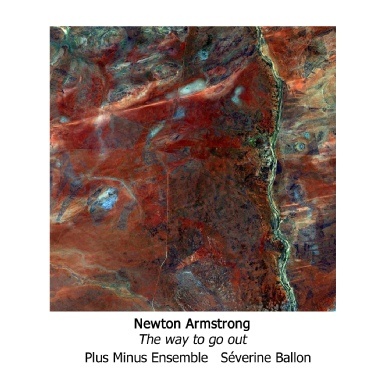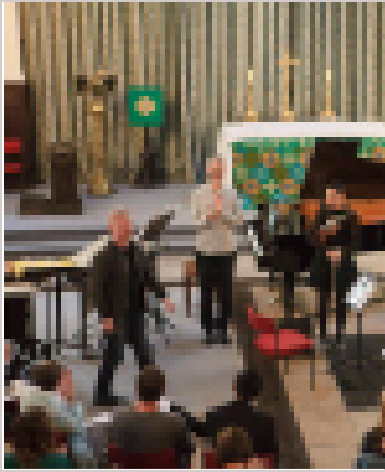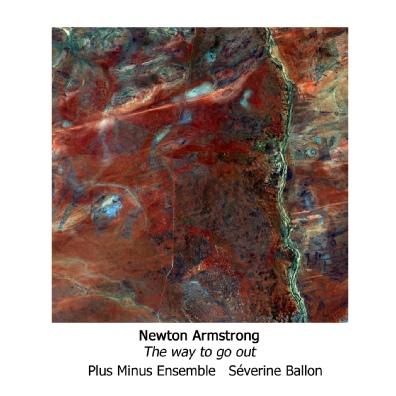Another Timbre TimHarrisonbre
at167 Newton Armstrong - ‘The way to go out’
Three works for small ensemble and electronics by the Australian-born, UK-resident composer Newton Armstrong, played by Plus Minus Ensemble and Séverine Ballon.
1. ‘Thread-surface’ (2018) 11:46 Youtube extract
Plus Minus Ensemble: Vicky Wright, bass clarinet Tom Pauwels, electric guitar
Roderick Chadwick, piano Katarzyna Zimiňska, violin Alice Purton, cello
2. ‘A line alongside itself’ (2019) 21:20 Youtube extract
Séverine Ballon, cellos
3. ‘The way to go out’ (2016) 11:44
Plus Minus Ensemble: Roderick Chadwick, piano Elsa Bradley, vibraphone
Katarzyna Zimiňska, violin Alice Purton, cello Mark Knoop, conductor

Interview with Newton Armstrong
Firstly, could you tell us a bit about the three pieces on the disc. They seem to share a similar soundworld, so are they related in any way as different parts of one project?
It's not a clearly defined project but the pieces are certainly related. Around five years ago I discovered the paintings of Warlimpirrnga Tjapaltjarri at an exhibition in New York. I began to study them closely, particularly the ways in which the lines coalesce into unstable, shimmering surfaces. The paintings seemed to emit a weird kind of gravity and I found that fascinating not only for the optical effect, but also because there was a vastness and a quality of time that was familiar but also ungraspable. This may all seem distant from your question, but it's how the soundworld of the pieces came about. I became interested in how the "in-between" of line and surface that's so palpable in the paintings could present itself in music as a kind of problem of listening focus. From there, I began to work on some new approaches to musical line, repetition, and layering. These approaches run through all three pieces in different ways.
Your answer explains the title ‘Thread-surface’, but what about the other titles – ‘A line alongside itself’ and ‘The way to go out’? What do these refer to?
A line alongside itself could have been used for any of the three pieces on the disc. It's a quite prosaic title, really. One way to think of a musical canon is as a line alongside itself, and all of these pieces are made from deformed, non-strict canons. In the Tjapaltjarri paintings, surface and texture emerge from the aggregate effect of placing self-similar (but non-identical) lines alongside themselves. I was working with related ideas.
The way to go out is borrowed from a Hunters and Collectors song. I don't remember how I ended up deciding on this one. There's possibly not much more to it than the fact that I found it quite open-ended and suggestive as a title, and the song is from an album that I've loved since I was a teenager. As it turned out, the piece was premiered a few days after the Brexit vote. For that performance the lyrics from the original song took on unintentional relevance: "And the way to go out was in a bottle of fear, in a body of anger and a gut full of beer."
I very much get the sense of shimmering surfaces in all three pieces, but I wouldn’t have guessed that they originated in response to a visual artist’s work. Does your interest in Tjapaltjarri’s work connect with growing up in Australia, and do you still feel Australian even though you haven’t lived there for nearly 20 years?
The first time I came to Europe, when I was around 20 years old, I couldn't escape the feeling that the sky might fall on my head. It was perhaps a difficulty in adjusting to unfamiliar light and space. But like many Australians of my generation, I was more or less educated as European, and this had also left me with a feeling of out-of-placeness in what is ostensibly my home.
All of this perhaps relates to my earlier comments about the tension between familiarity and ungraspability in the way that I encountered Tjapaltjarri's paintings. The patterns of light were familiar from growing up in Australia, but I couldn't get my half-European brain around the magnitudes of time, space and history that the paintings projected. I should also perhaps clarify that I wasn't trying to 'capture' anything of the paintings in music, however that might work. It's more that they were a catalyst to new ways for me to think about material and process, which in turn were entangled with what are perhaps quite generic mid-life preoccupations relating to origins and identity.
Not long after discovering the paintings, I read Bill Gammage's book The Greatest Estate on Earth. It's about the systems and science of First Nations land management in pre-colonial Australia. It closes with a challenge to new Australians: "We have a continent to learn". That has stuck with me, not so much as a statement of purpose (you can't learn a continent when you're living on an entirely different continent), but rather as an articulation of a moment of recognition that I had in that first encounter with the paintings.
Can you tell us about your background and how you came to experimental music?
I'm not sure that what I do is experimental music, at least not according to Cage's definition where outcomes are unforeseen. But there was definitely a moment when I first came to experimental music, when I met Chris Mann in 1990. That was a pivotal event. Up to that point I'd had the kind of broad musical education that was still possible before the neoliberalisation of everything. I'd also benefited from growing up with Salvation Army parents, which meant playing in brass bands and being surrounded by music. In 1990 I was studying composition at university. I basically wanted to be Stravinsky. Chris took an interest in me and I started spending a lot of time at his house, drinking tea and talking. He changed my mind about a lot of things and introduced me to people who were making music that excited me. The Melbourne experimental scene was thriving at that time, and I started going to concerts and performances that I previously wouldn't have heard about. It hasn't exactly been a straight-line trajectory since then, but I view that period as providing the foundations for the work I'm doing today.
I know that, having studied for your degree in Melbourne, you went to do several years of postgraduate study in the States. What drew you to Princeton?
I went to Princeton in 2001, then taught for a few yearsin the States before moving to London at the beginning of 2009. I was mostly busy with improvised music in the early 2000’s, and Princeton was one of the few places where it was possible to pursue that kind of thingas part of a graduate programme in composition. I was quite heavily involved with the more technical side of music-making as well, programming computers and building electronic instruments. There were a few people working between the computer science and music departments at Princeton, and I quickly became part of that group.
My work has moved from what I was doing in those days, but there are also some connecting threads. All of my recent instrumental music has included electronic sounds, and these are usually treated in an ‘instrumental’ way, with the loudspeakers integrated into the ensemble. And all of my work for the past twenty years has involved computer programming at some point in the process. In Thread-surface and The way to go out, the deformed canons that I was speaking about earlier were all created by algorithms that I designed.
Can you describe some of the other projects you are working on, or have been working on in recent years?
Firstly I should say that everything has been pretty much on hold since March. I have a full-time university job. Part of my contract is designated to being a composer, but with the addition of many new teaching and management responsibilities since the first period of Covid-related lockdown, that part has effectively disappeared.
That said, there are a few new projects in the works. Since the beginning of the year, Jennifer Walshe and I have been engaged in an on-and-off conversation about a collaborative project, and that’s starting to take shape, at least in outline form. There’s also apotentially larger-scale project in Australia, and a few smaller commissions. There’s a greater focus on collaboration in these new projects than there has been in my work of the past eight years or so. Composing can be a solitary activity at the best of times. With all of the mandated solitude of recent months, there’s perhaps a stronger than usual inclination towards connection and collaboration. I’ve been speaking with a lot of other composers and artists since the advent of Covid, and I don’t think I’m alone in responding in this way.

Newton Armstrong

Newton Armstrong at the first performance of ‘The way to go out’ at Music We’d Like To Hear, July 2016
